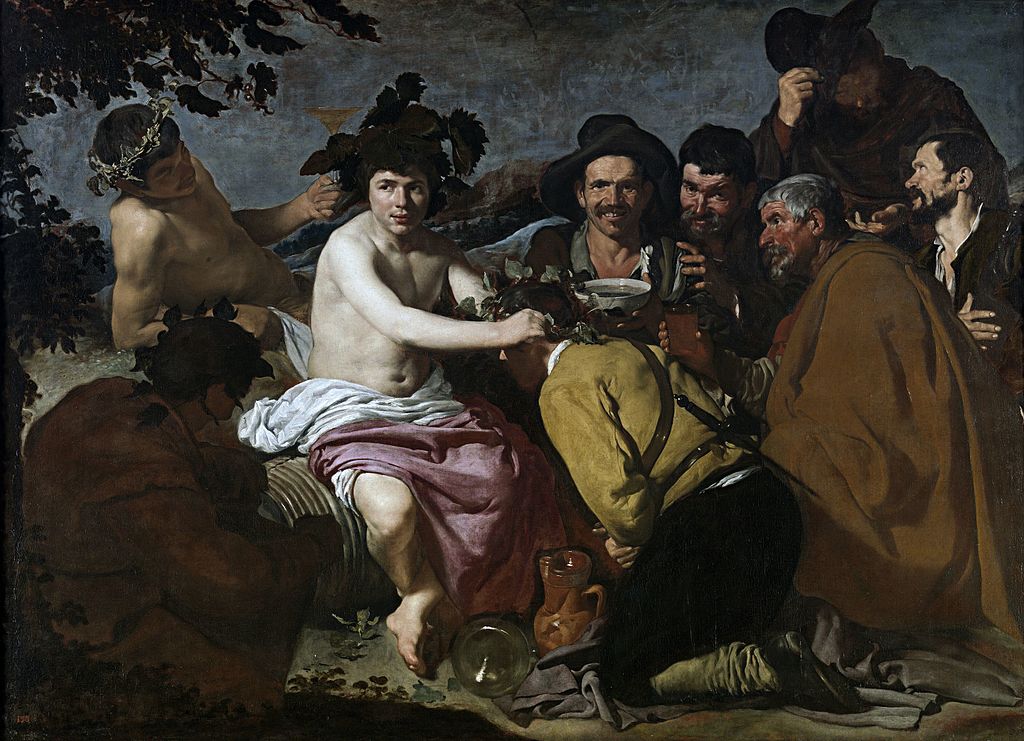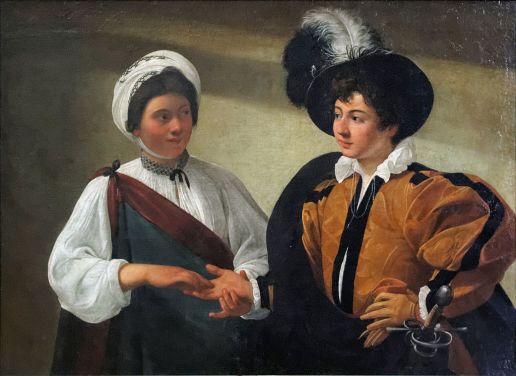|
Where? Room VIII of the Galleria Borghese
When? 1593-1594 Commissioned by? Unknown; Caravaggio probably used this painting to market himself for commissions. What do you see? A self-portrait of Caravaggio. He poses as the Roman god Bacchus, the god of grape harvest, wine, and intoxication. He is half-naked, wearing a white robe, and the ribbon around his robe lies on the table. We can see his muscular shoulder and arm. However, Bacchus does not look healthy. His skin is yellow and the white part of his eyes as well. Also, he has bluish lips. He wears a crown of ivy leaves on his head. He folds his hands and holds a bunch of white/yellow grapes between them. Bacchus sits at a stone table with on top a bunch of healthy black grapes, two peaches which have a similar color as Bacchus’ skin, and some vine leaves. Backstory: This painting is also known as ‘Sick Bacchus’ or ‘Self-Portrait as Bacchus.’ Caravaggio used a mirror to paint this work as he did more often later in his career. He probably painted it between 1593 and 1594. In 1607, the painting was confiscated by the Pope because of tax evasion by its owner, Giuseppe Cesari. The Pope gave the painting to his nephew, Scipione Caffarelli-Borghese. The painting was still reported to be in the Borghese collection in 1693. As the painting does not have a signature of Caravaggio, over the next centuries, it was attributed to several other painters. In 1927, it was attributed to Caravaggio again, and the large majority of people believes that this is a real Caravaggio. Who is Bacchus? Known in Greek mythology as Dionysus, Bacchus was the son of Zeus and Semele. He was the god of ecstasy, fertility, grape harvest, wine, and winemaking. He was a popular subject for artists as it allowed them to depict earthly pleasures. Around 1595, Caravaggio painted another painting of Bacchus which is in the Uffizi Museum. In contrast to his first painting, Bacchus looks quite healthy in that painting. Another example of an artist who has used Bacchus as the subject of his art is Diego Velázquez. He painted The Triumph of Bacchus in the Prado Museum.
Symbolism: The crown of ivy leaves is a symbol of Bacchus. Ivy was a sacred plant for Bacchus as it was thought to possess the power of preventing intoxication. The bunch of grapes also contains some rotten grapes. This is a symbol of death which is always looming and must have been in the mind of Caravaggio when he was in the hospital for a long time before he created this painting. At the same time, he holds the bunch of grapes close to his mouth suggesting that he is available for some intimacy. This suggestion is also emphasized by the ribbon of his robe, which is explicitly shown on the table and is ready to be opened. Moreover, the two peaches on the table symbolize a desire to be together with someone else.
Who is Caravaggio? Michelangelo Merisi Caravaggio (1571-1610) was born in Caravaggio near Milan, Italy. In 1592, he fled to Rome due to some trouble with the police. He arrived in Rome with almost no money and no place to live. Moreover, he got seriously ill and spent six months in the hospital. Luckily, he was a very talented painter. During his recovery, he painted Young Sick Bacchus. At the beginning of his career, he focused on naturally and realistically depicting human subjects and other elements in his paintings. This was very uncommon and makes the work of Caravaggio unique. To emphasize the imperfections of life, Caravaggio would get the models for his paintings from the streets (like beggars and prostitutes) and would buy some fruit on the market, accepting the fact that the fruit did not look perfect. Early in his career, Caravaggio also painted The Fortune Teller in the Louvre and the Capitoline Museums, and The Musicians in the Metropolitan Museum of Art.
Fun fact: Caravaggio was recovering from a serious illness when he painted this work. There are several theories on why he was in the hospital, ranging from a serious kick of a horse to malaria. However, during his recovery, there were still signs of sickness as we can see in this painting. He has jaundice, which leads to a yellowing of the skin and the white part of your eyes. It makes sense that Caravaggio used himself as the model for this painting. He was very poor in the beginning of his career (and also not rich during the rest of his life), and Caravaggio himself was the cheapest model he could find for this painting.
Interested in a copy for yourself? Poster or canvas.
Written by Eelco Kappe
References:
0 Comments
Leave a Reply. |
Categories
All
|
- Home
- Blog
-
Museums
- Alte Pinakothek
- Art Institute of Chicago
- Baltimore Museum of Art
- Barber Institute of Fine Arts
- Bargello
- Barnes Foundation
- British Museum
- Church of Sant’Anastasia
- Cleveland Museum of Art
- Courtauld Institute of Art
- Detroit Institute of Arts
- Frans Hals Museum
- Galleria Borghese
- Gallerie dell'Accademia
- Getty Museum
- Guggenheim
- Hermitage Museum
- Kunsthistorisches Museum
- Kunstmuseum Basel
- Legion of Honor Museum
- Louvre
- Mauritshuis
- Metropolitan Museum of Art
- Musee d’Orsay
- Museum of Fine Arts in Boston
- Museum of Modern Art
- National Gallery in London
- National Gallery of Art
- National Museum in Poznań
- Norton Simon Museum
- Ny Carlsberg Glyptotek
- Palace of Versailles
- Palazzo Pitti
- Palazzo Vecchio
- Petit Palais
- Philadelphia Museum of Art
- Prado
- Pushkin Museum
- Ravenna Art Museum
- Rijksmuseum
- San Diego Museum of Art
- Santa Maria delle Grazie
- St. Peter's Basilica
- Städel Museum
- Statens Museum for Kunst
- Tate Britain
- Tate Modern
- Timken Museum of Art
- Uffizi
- Vatican Museums
- Wallace Collection
-
Artists
- Altdorfer
- Anguissola
- Berlin Painter
- Bosch
- Botticelli
- Boucher
- Bronzino
- Bruegel the Elder
- Brunelleschi
- Cabanel
- Caillebotte
- Canova
- Caravaggio
- Carpeaux
- Cezanne
- Cimabue
- David
- Degas
- Delacroix
- De Maria
- Donatello
- El Greco
- Fontana
- Fra Angelico
- Fragonard
- Gauguin
- Gentileschi
- Gericault
- Gonzalez-Torres
- Goya
- Hals
- Hogarth
- Hokusai
- Ingres
- Leonardo da Vinci
- Lippi, Filippo
- Longhi, Barbara
- Lorrain
- Makovsky
- Manet
- Massys
- Matisse
- Merian
- Michelangelo
- Mochi
- Modigliani
- Monet
- Panini
- Parmigianino
- Perugino
- Picasso
- Pisanello
- Raphael
- Rembrandt
- Renoir
- Reynolds
- Rivera
- Rodin
- Rubens
- Scultori
- Seurat
- Steen
- Tintoretto
- Titian
- Toulouse-Lautrec
- Turner
- Uccello
- Van der Weyden
- Van Dyck
- Van Eyck
- Van Gogh
- Van Hemessen
- Vasari
- Velazquez
- Vermeer
- Veronese
- Vigée Le Brun
-
Locations
- Books
- About Us





